Wolfsmund
[Fair warning, the following review contains illustrations containing gore and nudity.]
When Adam had lived 130 years, he fathered a son in his own likeness, after his image, and named him Seth. The days of Adam after he fathered Seth were 800 years; and he had other sons and daughters. Thus all the days that Adam lived were 930 years, and he died.
When Seth had lived 105 years, he fathered Enosh. Seth lived after he fathered Enosh 807 years and had other sons and daughters. Thus all the days of Seth were 912 years, and he died.
When Enosh had lived 90 years, he fathered Kenan. Enosh lived after he fathered Kenan 815 years and had other sons and daughters. Thus all the days of Enosh were 905 years, and he died.
When Kenan had lived 70 years, he fathered Mahalalel. Dot dot dot. Et cetera and cetera. You get the idea.
The author11Tidbit for the academically inclined in the text-critical know. While no expert myself, I say author rather than authors because I've never actually heard a worthwhile argument in favour of JEDP theory, fascinating as it might be. It's not a big deal, but for those who are aware of the argument, I just thought I'd mention that I am too—just so you didn't get caught on the singular there and think, "Silly plebe." of the book of Genesis does this thing right at the beginning of the first book of the Pentateuch, right after the Fall of Humanity and right after the Cain and Abel incident. It's rather an establishing shot for the whole of the rest of the Pentateuch. It's like Orson Welles' fabulous crane shot introducing Touch of Evil. It basically tells you everything you need to know to make sense of what follows. It gives you foundation enough not to be irreparably lost. It's ambiance and context and foreshadowing all in one. And it works magnificently for those with patience enough to care.
Genesis 5, from which I cribbed above, reads as a litany of death. So and so was born, lived so long, had a particular son through which the dynasty would pass, lived for so many years, and then died. Next! The book repeats the formula with rare exception for ten generations. It's a bit taxing to read but drives home the author's point that after things went haywire in the Earthly Paradise, there is no stopping death. Things were promised to get better, but they just aren't. No matter how long a person lives, no matter how rad they were, they all die in the end. It's macabre (though treated a bit sterile in this early chapter—things get cooking later with details to spare) and even tedious, but it's to a particular end.
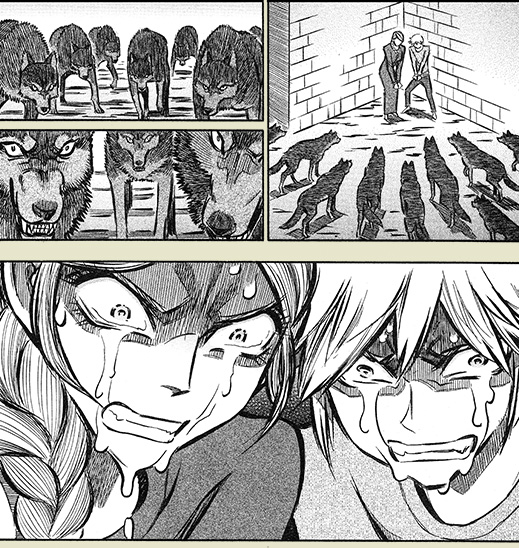 Fact: what you expect to happen in the next panel does indeed happen.
Fact: what you expect to happen in the next panel does indeed happen.
Wolfsmund has the same thing going on. The first two volumes are relentless. They're gruesome and draining and don't really seem to go anywhere. It's just ugly death after ugly death, and Kuji seems to introduce characters only to see them tortured and dead by chapter's end. It's maddening and sometimes off-putting. But then, like the book of Genesis, suddenly things start happening.22I could also compare it to 100 Bullets except for the fact that Wolfsmund appears to actually be a pretty decent book. The loose threads of a plot begin to weave into sight and all of that earlier horror begins to make a bit more sense.
I don't know if the completed work will end up wholly justifying the first six or so chapters, but so far Wolfsmund is well on it's way to that end. Where I was at the time on the fence and ready to give up the series if the wind just happened to blow me a little too hard in one direction or another, I'm now pretty thoroughly anticipating seeing where the next two volumes will take the story. And whether the book will wrap up then or continue on as something new or return, bafflingly, to some sort of status quo, I don't know. By the end of volume 4, things certainly seem pitched toward climax, but who's to say.
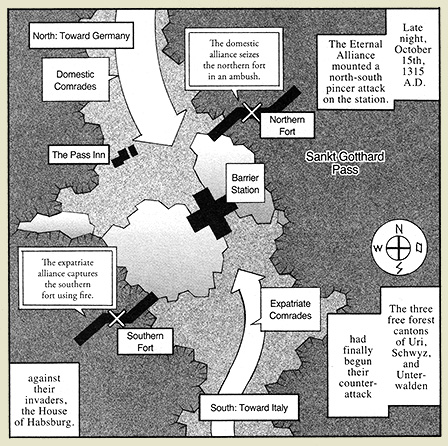 This kind of battlemap appears more and more as the story gets cookin'.
This kind of battlemap appears more and more as the story gets cookin'.
That so many seemingly main characters die so frequently is probably a gutsy move on Kuji's part. It's a choice that threatens to alienate readers before they have a chance to invest in the plot, when it eventually arrives.33And not just threatens but often actually succeeds. Flipping through some forums to see whether there was any news on how long the series would be, I discovered large swaths who couldn't get past volume 1, simply because there was no single protagonist character on whom to hang their hat. Fans of gore and gruesome deaths will probably stick around for long enough, as Kuji seems to delight in finding new ways to kill off sympathetic characters. Even well after the initial formula for each chapter gives way to a more spanning and directed narrative, the creator remains well-pleased to torture, kill, and maim with abandon. A man has molten lead poured into his face. A child has his head torn off by starving wolves. A young girl is hung naked upside-down and her throat slit. A woman has her face punched in with a plate-clad fist. A man is crushed under a heavy gate. Scalding water, boiling oil, firebombs, swords, hammers, sickles. Everybody dies and dies badly. It's pretty rough.
 This is not the worst thing that happens to a person in the book
This is not the worst thing that happens to a person in the book
Along with all the violence, the superstructure of Kuji's women may be off-putting to some readers—or at least present a curiosity. These 14th century Swiss women are often enough stripped of clothing before being murdered, and Kuji draws each of them with tremendously large breasts. As well, they look artificially enhanced (as they do not hang in ways that physics and natural biology would generally allow for). It's a curious choice and one for which I'd be irresponsible to even begin hunting for motivations—but it can be entirely distracting I guess.
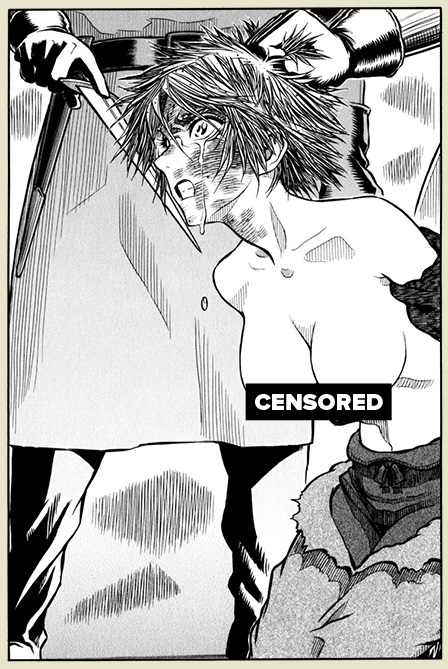 Click image for anatomy lesson
Click image for anatomy lesson
Still for all that, there really is a solid storyline that develops. Wolfsmund is a kind of fan-fictional retelling of the fall a particular garrison in an isolated Swiss pass. It's a little bit confusing as it takes place on 15 October 1315 and seems to be concerned with the Battle of Margarten, which took place a month later on 15 November. Maybe the current arc is merely prelude for the later battle with Leopold. Whichever the case, Kuji offers an exciting version of the events and gives her characters near superhuman martial prowess. William and Walter Tell are not only expert marksmen, but they can catch themselves on shear rock walls by a couple fingertips on centimeter large outcroppings. A farmgirl's husband was murdered she and her two servants become experts in a farming-implement-focused combat style that her late husband had developed. Et cetera. There are speedlines and choreographed action out the wazoo—and it's actually kind of magnificent in its way.
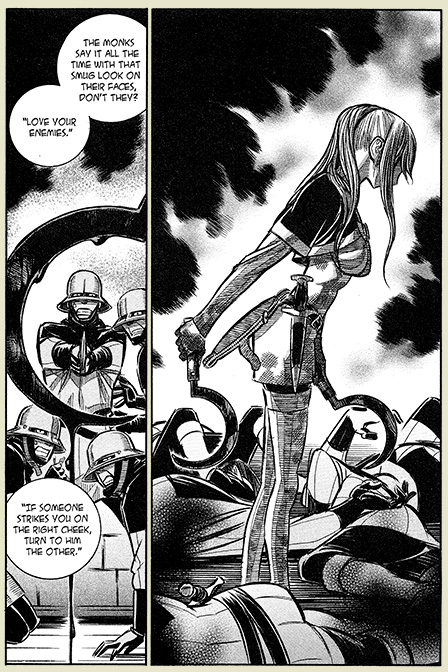 She is basically the Princess Bride if Buttercup had stayed on the farm.
She is basically the Princess Bride if Buttercup had stayed on the farm.
Those looking for a staid encounter with the dry history of a bloody, lopsided battle44In actual history, the canton confederates ambushed the professional Hapsburg knights by dropping a bunch of logs and rocks on them in a narrow pass, culling their numbers and driving them to flee. The fleeing Hapsburgs were cut down from behind and butchered by the merciless Swiss. are going to be probably disappointed—such was never Kuji's aim. Rather, she has put together a brutal, sentimental action-film spectacular. In all honesty, I probably would have preferred the more true-to-canon version of things, but not only do I respect Kuji's choice, I also have come to pretty thoroughly enjoy it. It's not by any stretch a perfect work, but especially for one's first headlining project, she shows an able commitment to her vision. I look forward to seeing how she directs the narrative going forward and my fingers are crossed that she'll at least spare one or two of the personalities in the book I've come to enjoy.
Whatever issues I had with the above image of the girl being executed, in all fairness, Kuji absolutely draws the heck out of her face. Check this out. It's just a gorgeous piece of illustration.
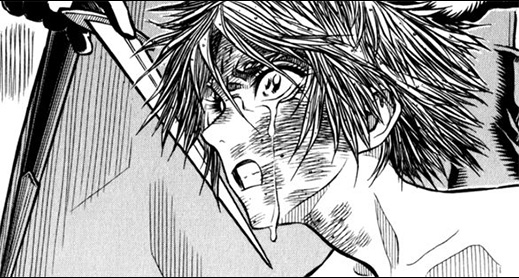
Good Ok Bad features reviews of comics, graphic novels, manga, et cetera using a rare and auspicious three-star rating system. Point systems are notoriously fiddly, so here it's been pared down to three simple possibilities:
3 Stars = Good
2 Stars = Ok
1 Star = Bad
I am Seth T. Hahne and these are my reviews.
Browse Reviews By
Other Features
- Best Books of the Year:
- Top 50 of 2024
- Top 50 of 2023
- Top 100 of 2020-22
- Top 75 of 2019
- Top 50 of 2018
- Top 75 of 2017
- Top 75 of 2016
- Top 75 of 2015
- Top 75 of 2014
- Top 35 of 2013
- Top 25 of 2012
- Top 10 of 2011
- Popular Sections:
- All-Time Top 500
- All the Boardgames I've Played
- All the Anime Series I've Seen
- All the Animated Films I've Seen
- Top 75 by Female Creators
- Kids Recommendations
- What I Read: A Reading Log
- Other Features:
- Bookclub Study Guides











